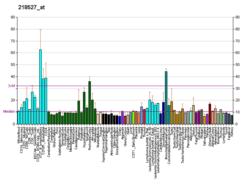Aprataxin
Aprataxin is a protein that in humans is encoded by the APTX gene.[5][6][7]
This gene encodes a member of the histidine triad (HIT) superfamily, some of which have nucleotide-binding and diadenosine polyphosphate hydrolase activities. The encoded protein may play a role in single-stranded DNA repair. Mutations in this gene have been associated with ataxia–ocular apraxia. Multiple transcript variants encoding distinct isoforms have been identified for this gene, however, the full length nature of some variants has not been determined.[7]
Function
Aprataxin removes AMP from DNA ends following abortive ligation attempts by DNA Ligase IV during non-homologous end joining, thereby permitting subsequent attempts at ligation.[8][9]
DNA strand breaks
Ataxia oculomotor apraxia-1 is a neurological disorder caused by mutations in the APTX gene that encodes aprataxin.[10] The neurological disorder appears to be caused by the gradual accumulation of unrepaired DNA strand breaks resulting from abortive DNA ligation events.[10]
Premature aging
Aptx−/− mutant mice have been generated, but they lack an obvious phenotype.[10] Another mouse model was generated in which a mutation of superoxide dismutase I (SOD1) is expressed in an Aptx−/− mouse.[11] The SOD1 mutation causes a reduction in transcription recovery following oxidative stress. These mice showed accelerated cellular senescence. This study also demonstrated a protective role of Aptx in vivo and suggested that the loss of Aptx function results in progressive accumulation of DNA breaks in the nervous system, triggering hallmarks of systemic premature aging [11] (see DNA damage theory of aging).
Interactions
Aprataxin has been shown to interact with:
References
- GRCh38: Ensembl release 89: ENSG00000137074 - Ensembl, May 2017
- GRCm38: Ensembl release 89: ENSMUSG00000028411 - Ensembl, May 2017
- "Human PubMed Reference:". National Center for Biotechnology Information, U.S. National Library of Medicine.
- "Mouse PubMed Reference:". National Center for Biotechnology Information, U.S. National Library of Medicine.
- Date H, Onodera O, Tanaka H, Iwabuchi K, Uekawa K, Igarashi S, Koike R, Hiroi T, Yuasa T, Awaya Y, Sakai T, Takahashi T, Nagatomo H, Sekijima Y, Kawachi I, Takiyama Y, Nishizawa M, Fukuhara N, Saito K, Sugano S, Tsuji S (Oct 2001). "Early-onset ataxia with ocular motor apraxia and hypoalbuminemia is caused by mutations in a new HIT superfamily gene". Nat Genet. 29 (2): 184–8. doi:10.1038/ng1001-184. PMID 11586299.
- Moreira MC, Barbot C, Tachi N, Kozuka N, Uchida E, Gibson T, Mendonca P, Costa M, Barros J, Yanagisawa T, Watanabe M, Ikeda Y, Aoki M, Nagata T, Coutinho P, Sequeiros J, Koenig M (Oct 2001). "The gene mutated in ataxia-ocular apraxia 1 encodes the new HIT/Zn-finger protein aprataxin". Nat Genet. 29 (2): 189–93. doi:10.1038/ng1001-189. PMID 11586300.
- "Entrez Gene: APTX aprataxin".
- Rass U, Ahel I, West SC (December 2008). "Molecular mechanism of DNA deadenylation by the neurological disease protein aprataxin". J. Biol. Chem. 283 (49): 33994–4001. doi:10.1074/jbc.M807124200. PMC 2662222. PMID 18836178.
- Reynolds JJ, El-Khamisy SF, Katyal S, Clements P, McKinnon PJ, Caldecott KW (March 2009). "Defective DNA ligation during short-patch single-strand break repair in ataxia oculomotor apraxia 1". Mol. Cell. Biol. 29 (5): 1354–62. doi:10.1128/MCB.01471-08. PMC 2643831. PMID 19103743.
- Ahel I, Rass U, El-Khamisy SF, Katyal S, Clements PM, McKinnon PJ, Caldecott KW, West SC (2006). "The neurodegenerative disease protein aprataxin resolves abortive DNA ligation intermediates". Nature. 443 (7112): 713–6. doi:10.1038/nature05164. PMID 16964241.
- Carroll J, Page TK, Chiang SC, Kalmar B, Bode D, Greensmith L, Mckinnon PJ, Thorpe JR, Hafezparast M, El-Khamisy SF (2015). "Expression of a pathogenic mutation of SOD1 sensitizes aprataxin-deficient cells and mice to oxidative stress and triggers hallmarks of premature ageing". Hum. Mol. Genet. 24 (3): 828–40. doi:10.1093/hmg/ddu500. PMC 4291253. PMID 25274775.
- Date H, Igarashi S, Sano Y, Takahashi T, Takahashi T, Takano H, Tsuji S, Nishizawa M, Onodera O (December 2004). "The FHA domain of aprataxin interacts with the C-terminal region of XRCC1". Biochem. Biophys. Res. Commun. 325 (4): 1279–85. doi:10.1016/j.bbrc.2004.10.162. PMID 15555565.
- Gueven N, Becherel OJ, Kijas AW, Chen P, Howe O, Rudolph JH, Gatti R, Date H, Onodera O, Taucher-Scholz G, Lavin MF (May 2004). "Aprataxin, a novel protein that protects against genotoxic stress". Hum. Mol. Genet. 13 (10): 1081–93. doi:10.1093/hmg/ddh122. PMID 15044383.
- Clements PM, Breslin C, Deeks ED, Byrd PJ, Ju L, Bieganowski P, Brenner C, Moreira MC, Taylor AM, Caldecott KW (November 2004). "The ataxia-oculomotor apraxia 1 gene product has a role distinct from ATM and interacts with the DNA strand break repair proteins XRCC1 and XRCC4". DNA Repair (Amst.). 3 (11): 1493–502. doi:10.1016/j.dnarep.2004.06.017. PMID 15380105.
Further reading
- Aicardi J, Barbosa C, Andermann E, et al. (1989). "Ataxia-ocular motor apraxia: a syndrome mimicking ataxia-telangiectasia". Ann. Neurol. 24 (4): 497–502. doi:10.1002/ana.410240404. PMID 3239952.
- Gascon GG, Abdo N, Sigut D, et al. (1995). "Ataxia-oculomotor apraxia syndrome". J. Child Neurol. 10 (2): 118–22. doi:10.1177/088307389501000210. PMID 7782601.
- Hannan MA, Sigut D, Waghray M, Gascon GG (1995). "Ataxia-ocular motor apraxia syndrome: an investigation of cellular radiosensitivity of patients and their families". J. Med. Genet. 31 (12): 953–6. doi:10.1136/jmg.31.12.953. PMC 1016697. PMID 7891378.
- Moreira MC, Barbot C, Tachi N, et al. (2001). "Homozygosity mapping of Portuguese and Japanese forms of ataxia-oculomotor apraxia to 9p13, and evidence for genetic heterogeneity". Am. J. Hum. Genet. 68 (2): 501–8. doi:10.1086/318191. PMC 1235299. PMID 11170899.
- Brenner C (2002). "Hint, Fhit, and GalT: function, structure, evolution, and mechanism of three branches of the histidine triad superfamily of nucleotide hydrolases and transferases". Biochemistry. 41 (29): 9003–14. doi:10.1021/bi025942q. PMC 2571077. PMID 12119013.
- Shimazaki H, Takiyama Y, Sakoe K, et al. (2002). "Early-onset ataxia with ocular motor apraxia and hypoalbuminemia: the aprataxin gene mutations". Neurology. 59 (4): 590–5. doi:10.1212/wnl.59.4.590. PMID 12196655.
- Strausberg RL, Feingold EA, Grouse LH, et al. (2003). "Generation and initial analysis of more than 15,000 full-length human and mouse cDNA sequences". Proc. Natl. Acad. Sci. U.S.A. 99 (26): 16899–903. doi:10.1073/pnas.242603899. PMC 139241. PMID 12477932.
- Tranchant C, Fleury M, Moreira MC, et al. (2004). "Phenotypic variability of aprataxin gene mutations". Neurology. 60 (5): 868–70. doi:10.1212/01.wnl.0000048562.88536.a4. PMID 12629250.
- Le Ber I, Moreira MC, Rivaud-Péchoux S, et al. (2003). "Cerebellar ataxia with oculomotor apraxia type 1: clinical and genetic studies". Brain. 126 (Pt 12): 2761–72. doi:10.1093/brain/awg283. PMID 14506070.
- Sekijima Y, Hashimoto T, Onodera O, et al. (2004). "Severe generalized dystonia as a presentation of a patient with aprataxin gene mutation". Mov. Disord. 18 (10): 1198–200. doi:10.1002/mds.10526. PMID 14534929.
- Ota T, Suzuki Y, Nishikawa T, et al. (2004). "Complete sequencing and characterization of 21,243 full-length human cDNAs". Nat. Genet. 36 (1): 40–5. doi:10.1038/ng1285. PMID 14702039.
- Sano Y, Date H, Igarashi S, et al. (2004). "Aprataxin, the causative protein for EAOH is a nuclear protein with a potential role as a DNA repair protein". Ann. Neurol. 55 (2): 241–9. doi:10.1002/ana.10808. PMID 14755728.
- Gueven N, Becherel OJ, Kijas AW, et al. (2004). "Aprataxin, a novel protein that protects against genotoxic stress". Hum. Mol. Genet. 13 (10): 1081–93. doi:10.1093/hmg/ddh122. PMID 15044383.
- Humphray SJ, Oliver K, Hunt AR, et al. (2004). "DNA sequence and analysis of human chromosome 9". Nature. 429 (6990): 369–74. doi:10.1038/nature02465. PMC 2734081. PMID 15164053.
- Habeck M, Zühlke C, Bentele KH, et al. (2004). "Aprataxin mutations are a rare cause of early onset ataxia in Germany". J. Neurol. 251 (5): 591–4. doi:10.1007/s00415-004-0374-7. PMID 15164193.
- Hirano M, Nishiwaki T, Kariya S, et al. (2004). "Novel splice variants increase molecular diversity of aprataxin, the gene responsible for early-onset ataxia with ocular motor apraxia and hypoalbuminemia". Neurosci. Lett. 366 (2): 120–5. doi:10.1016/j.neulet.2004.05.034. PMID 15276230.
- Amouri R, Moreira MC, Zouari M, et al. (2005). "Aprataxin gene mutations in Tunisian families". Neurology. 63 (5): 928–9. doi:10.1212/01.wnl.0000137044.06573.46. PMID 15365154.
- Clements PM, Breslin C, Deeks ED, et al. (2005). "The ataxia-oculomotor apraxia 1 gene product has a role distinct from ATM and interacts with the DNA strand break repair proteins XRCC1 and XRCC4". DNA Repair (Amst.). 3 (11): 1493–502. doi:10.1016/j.dnarep.2004.06.017. PMID 15380105.
External links
- GeneReviews/NCBI/NIH/UW entry on Ataxia with Oculomotor Apraxia Type 1
- OMIM entries on Ataxia with Oculomotor Apraxia Type 1
- Human APTX genome location and APTX gene details page in the UCSC Genome Browser.





